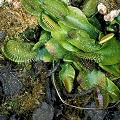Q: Winter dormancy? Huh? What?

Mugly!
A: Now just because your plant is stopping in growth and not doing
very much, it may not be dying. It might just be entering its autumn
dormancy!
There is no doubt that a Venus flytrap entering dormancy can look
pretty miserable (look at the weatherbeaten plants to the right), but this
is all part of life's magical cycle of renewal.
I get so many questions about dormancy and Venus flytraps that I want to
be very specific. So pay attention!
- You really should give your plants a dormancy period. They require it,
just like you must go to sleep once a day. (Ah,
college years and sleep deprivation---I remember them well.) I know that the expert
growers out there will disagree with me, but for you beginners---give the plants dormancy!
- If your plant is growing more and more slowly (i.e.
it is no longer producing new traps), and it is late summer, you can assume dormancy is approaching.
- If you bought a new plant during the spring or summer, and by winter it will have been growing
for at least four months, it would be
safe to assume you can give it a dormancy during the winter. If it has grown for less time, or perhaps you bought it during
the winter, don't force it into dormancy---wait until next winter
-
Dormancy temperatures should be chilly but not freezing. Do not let your
plants freeze! Sunlight is fine during dormancy. Keep the soil just barely moist--top water
or tray watering is fine, just keep them slightly most. Remember these
plants expect the chilly (not arctic, not hot jungle) winters of their native coastal
North Carolina or South Carolina. For your interest, below are some monthly average temperature highs,
lows, and means for Wilmington, North Carolina in both Farenheit and
Celsius. For details on this information,
refer to my data source, www.weather.com.
Oh, and if you are an expert grower who is able to keep your plant alive with a freeze, great--but do not email me with corrections. This is a page for novices, ok? Not a page for you to show me how you have bent the rules...
| Month | Ave. High | Ave. Low | Mean |
|---|---|---|---|
| Jan | 13°C (55°F) | 1°C (34°F) | 7°C (45°F) |
| Feb | 14°C (58°F) | 2°C (36°F) | 8°C (47°F) |
| Mar | 18°C (65°F) | 6°C (43°F) | 12°C (54°F) |
| Apr | 23°C (74°F) | 10°C (50°F) | 17°C (62°F) |
| May | 27°C (80°F) | 15°C (59°F) | 21°C (70°F) |
| Jun | 29°C (85°F) | 19°C (67°F) | 25°C (77°F) |
| Jul | 31°C (88°F) | 22°C (71°F) | 27°C (80°F) |
| Aug | 31°C (87°F) | 22°C (71°F) | 26°C (79°F) |
| Sep | 29°C (85°F) | 18°C (65°F) | 24°C (75°F) |
| Oct | 24°C (76°F) | 12°C (53°F) | 18°C (65°F) |
| Nov | 21°C (69°F) | 7°C (44°F) | 14°C (57°F) |
| Dec | 15°C (59°F) | 3°C (37°F) | 9°C (49°F) |
The next FAQ entry describes ways you can give
your plant a nice winter dormancy.
Page citations: Rice, B.A. 2006a; www.weather.com.